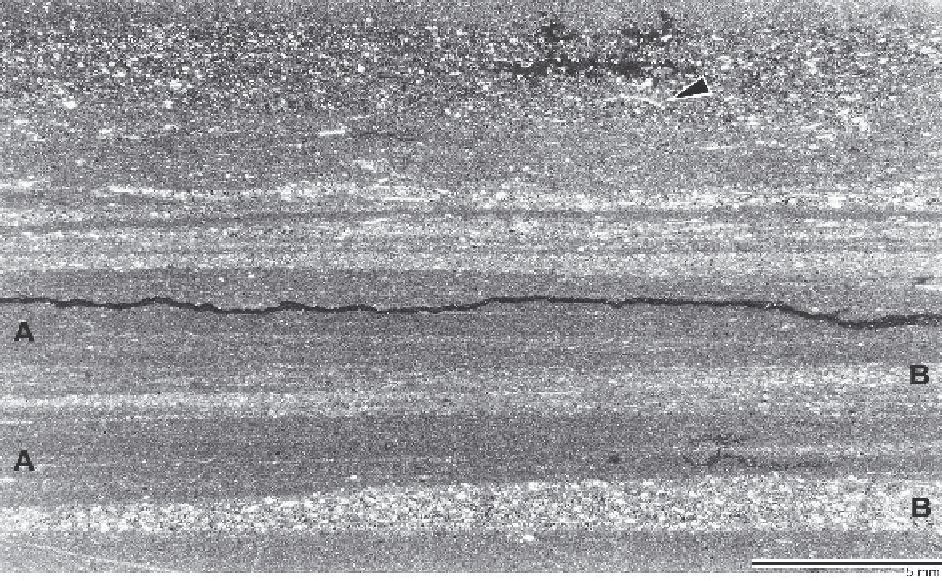Geology Reference
In-Depth Information
Fig. 12.10.
Estimating paleo-oxygenation
. The fabric of the black laminated lime mudstone is characterized by couplets of
densely spaced dark and bright laminae (A), alternating with light layers composed of silt-sized grains (B). The lack of
bioturbation and fossils in the microlaminated sets reflects anaerobic conditions (Oxygen-Restricted Biofacies - ORB 2) that
alternated with dysaerobic layers containing a few ostracod shells (arrow; ORB 4). A younger, thin black, more or less
horizontal fissure enriched in bitumen is intercalated. Late Triassic (Norian, Seefeld facies): Wiestal quarry, Hallein, Austria.
Raiswell, E., Buckley, F., Berner, R.A., Anderson, T.F. (1988):
Degree of pyritization of iron as a paleoenvironmental in-
dicator of bottom-water oxygenation. - Journal of Sedi-
mentary Petrology,
58
, 812-819
Rhoads, D.C., Morse, J.W. (1971): Evolutionary and ecologic
significance of oxygen-deficient marine basins. - Lethaia,
4
, 413-428
Savrda, C.W., Bottjer, D.J. (1991): Oxygen-related biofacies
in marine strata: an overview and update. - In: Tyson, R.V.,
Pearson, T. (eds., 1991): Modern and ancient continental
shelf anoxia. - Geological Society of London, Special
Publication,
58
, 201-219
Southam, J.R., Peterson, W.H., Brass, G.W. (1982): Dynam-
ics of anoxia. - Palaeogeography, Palaeoclimatology,
Palaeoecology,
40
, 183-198
Tyson, R.V., Pearson, T. (eds., 1991): Modern and ancient
continental shelf anoxia. - Geological Society of London,
Special Publication,
58
, 470 pp.
Wignall, P.B. (1994): Black shales. - Geology and Geophys-
ics Monograph Series,
30
, 136 pp., Oxford (Oxford Uni-
versity Press)
Wignall, P.B., Hallam, A. (1991): Biofacies, stratigraphic dis-
tribution and depositional models of British onshore Ju-
rassic black shales. - In: Tyson, R.V., Pearson, T.H. (eds.):
Modern and ancient continental shelf anoxia. - Geologi-
cal Society London, Special Publication,
58
, 291-309
Further reading:
K166
12.1.6 Seawater Temperature
Sea-water temperatures and the prevailing paleoclimate
exerted a major control on the depositional patterns,
diagenetic pathways and reservoir styles of carbonates
(Sun and Esteban 1994). Regional and global changes
of water temperatures are regarded as essential in di-
versity reduction and extinction of organisms. The re-
construction of paleo-water temperatures is largely
based on biotic and geochemical proxies.
Temperature is one of the most important factors in
governing life processes and distribution of organisms.
Vital life processes in the oceans function normally only
within defined ranges of temperature (approximately
2 °C to 40 °C). Seawater temperature varies laterally
with changes in latitudes and vertically with depths.
The depth of the most rapid temperature decline below
the warm surface water is called the thermocline. This
zone is a persistent feature in the tropics, but is absent
in the polar zone. The temperatures of tropical surface
waters range between about 20 and 30 °C throughout
the year. In temperate surface waters warm tempera-
tures are restricted to summer. Water temperatures be-
low the thermocline are rather constant.

